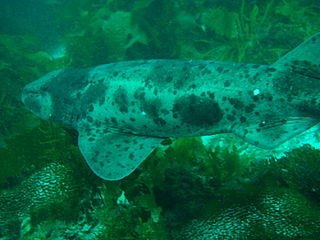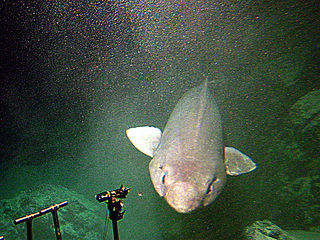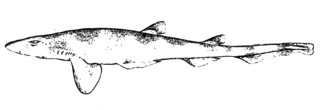
Carcharhiniformes, the ground sharks, are the largest order of sharks, with over 270 species. They include a number of common types, such as catsharks, swellsharks, and requiem sharks.

The Lamniformes are an order of sharks commonly known as mackerel sharks. It includes some of the most familiar species of sharks, such as the great white as well as less familiar ones, such as the goblin shark and megamouth shark.

Carpet sharks are sharks classified in the order Orectolobiformes. Sometimes the common name "carpet shark" is used interchangeably with "wobbegong", which is the common name of sharks in the family Orectolobidae. Carpet sharks have five gill slits, two spineless dorsal fins, and a small mouth that does not extend past the eyes. Many species have barbels.

The Triakidae or houndsharks are a family of ground sharks, consisting of about 40 species in nine genera. In some classifications, the family is split into two subfamilies, with the genera Mustelus, Scylliogaleus and Triakis in the subfamily Triakinae, and the remainders in the subfamily Galeorhininae.

The slender smooth-hound or gollumshark is a species of ground shark in the family Pseudotriakidae. It is endemic to the waters around New Zealand, where it is usually found close to the bottom over the continental slope at depths of 300–600 m (980–1,970 ft). An extremely slim, plain brownish shark reaching 1.1 m (3.6 ft) in length, the slender smooth-hound can be identified by its broad, flattened head with a long, distinctively bell-shaped snout. Its mouth is angular with short furrows at the corners, and contains a very high number of tooth rows in both jaws. Its two dorsal fins are roughly equal in size.

Cephaloscyllium is a genus of catsharks, and part of the family Scyliorhinidae, commonly known as swellsharks because of their ability to inflate their bodies with water or air as a defense against predators. These sluggish, bottom-dwelling sharks are found widely in the tropical and temperate coastal waters of the Indian and Pacific Oceans. They have stocky, spindle-shaped bodies and short, broad, and flattened heads. The mouth is capacious, containing many small teeth and lacking furrows at the corners. The two dorsal fins are placed far back on the body, with the first much larger than the second. Different species have various color patterns of saddles, blotches, reticulations, and/or spots. The largest members of the genus can grow over 1 m (3.3 ft) in length. Swellsharks prey on a variety of fishes and invertebrates, and are oviparous, with females producing egg capsules in pairs. They are harmless and have been deemed of having no commercial value.

The Pondicherry shark is an extremely rare species of requiem shark, in the family Carcharhinidae. A small and stocky gray shark, it grows not much longer than 1 m (3.3 ft) and has a fairly long, pointed snout. This species can be identified by the shape of its upper teeth, which are strongly serrated near the base and smooth-edged near the tip, and by its first dorsal fin, which is large with a long free rear tip. Furthermore, this shark has prominent black tips on its pectoral fins, second dorsal fin, and caudal fin lower lobe.

The false catshark or sofa shark is a species of ground shark in the family Pseudotriakidae, and the sole member of its genus. It has a worldwide distribution, and has most commonly been recorded close to the bottom over continental and insular slopes, at depths of 500–1,400 m (1,600–4,600 ft). Reaching 3.0 m (9.8 ft) in length, this heavy-bodied shark can be readily identified by its elongated, keel-like first dorsal fin. It has long, narrow eyes and a large mouth filled with numerous tiny teeth. It is usually dark brown in color, though a few are light gray.

The barbeled houndshark is a species of ground shark and the only member of the family Leptochariidae. This demersal species is found in the coastal waters of the eastern Atlantic Ocean from Mauritania to Angola, at depths of 10–75 m (33–246 ft). It favors muddy habitats, particularly around river mouths. The barbeled houndshark is characterized by a very slender body, nasal barbels, long furrows at the corners of the mouth, and sexually dimorphic teeth. Its maximum known length is 82 cm (32 in).

Haploblepharus is a genus of deepwater catsharks, belonging to the family Pentanchidae, containing four species of shysharks. Their common name comes from a distinctive defensive behavior in which the shark curls into a circle and covers its eyes with its tail. The genus is endemic to southern Africa, inhabiting shallow coastal waters. All four species are small, stout-bodied sharks with broad, flattened heads and rounded snouts. They are characterized by very large nostrils with enlarged, triangular flaps of skin that reach the mouth, and deep grooves between the nostrils and the mouth. Shysharks are bottom-dwelling predators of bony fishes and invertebrates. They are oviparous, with the females laying egg capsules. These harmless sharks are of no commercial or recreational interest, though their highly limited distributions in heavily fished South African waters are of potential conservation concern.

The Antilles catshark is a common but little-known species of deepwater catshark, belonging of the family Pentanchidae. It is found on or near the bottom at a depth of 293–695 m (961–2,280 ft) off Florida and the West Indies from Jamaica to Martinique. It was once regarded as a subspecies of the similar roughtail catshark, along with the longfin sawtail catshark. Growing to 46 cm (18 in) long, the Antilles catshark is a slender species with a marbled color pattern of dark saddles and blotches, as well as a crest of enlarge dermal denticles along the front part of its dorsal caudal fin margin. It feeds on shrimp and may have schooling habits. Reproduction is oviparous.

The gecko catshark is a species of deepwater catshark, belonging to the family Pentanchidae, native to the northwestern Pacific Ocean from southern Japan to Taiwan, and possibly also off Vietnam. It is a common, demersal species found at depths of 100–900 m (330–2,950 ft). Its body is slender, with a pattern of dark saddles and blotches. The dorsal and caudal fins are edged in white, and there is a prominent crest of enlarged dermal denticles along the dorsal edge of the caudal fin. The gecko catshark is a schooling, opportunistic predator of bony fishes, cephalopods, and crustaceans. It is oviparous, with females producing two vase-shaped egg capsules at a time. This species is captured as bycatch, but does not appear to be threatened by fishery activities at present and has been assessed as Least Concern by the International Union for Conservation of Nature (IUCN).

The slender sawtail catshark is a little-known species of deepwater catshark, part of the family Pentanchidae, endemic to northern Australia. It is found over the continental slope in 290–470 m (950–1,540 ft) on water. Growing to 34 cm (13 in) long, this shark has a slim gray body with four dark saddle markings below the dorsal fins and on the caudal fin, as well as a prominent crest of enlarged dermal denticles along the dorsal edge of the caudal fin. The slender sawtail catshark is not valued by fisheries but is taken as bycatch. The International Union for Conservation of Nature (IUCN) presently lacks enough information to assess its conservation status.

The peppered catshark is a common but little-known species of shark belonging to the family Pentanchidae, the deepwater catsharks. This species inhabits depths of 130–1,326 m (427–4,350 ft) in the northern Gulf of California. It is found on or near the ocean floor, and conducts seasonal migrations, spending winter in deeper water. Reaching a length of 37 cm (15 in), this species has a slender grayish body with a fine covering of black dots. On the dorsal edge of its caudal fin is a prominent crest of enlarged dermal denticles. It is oviparous, with the reproductive period probably lasting from May to September. The International Union for Conservation of Nature (IUCN) has listed the peppered catshark under Least Concern, as it faces no significant threats from human activity.

The blacktip sawtail catshark is a species of shark belonging to the family Pentanchidae, the deepwater catsharks, This species is found off the coasts of Taiwan and the Philippines. It is demersal in nature and occurs deeper than 60 m (200 ft). Growing up to 46 cm (18 in) long, this slim-bodied species is characterized by its plain brownish dorsal coloration with dark tips on the dorsal and caudal fins, and a prominent crest of enlarged dermal denticles on the upper edge of the caudal fin. It is oviparous, with females producing encapsulated eggs two at a time year-round. The blacktip sawtail catshark is caught incidentally in bottom trawls and used for fishmeal in Taiwan.

The dwarf sawtail catshark is a species of shark belonging to the family Pentanchidae, the deepwater catsharks. This shark is found exclusively in the deep waters off Luzon in the Philippines. Unlike other members of its genus, this slender, diminutive shark has a short, rounded snout and very short furrows at the corners of its jaws. It has indistinct darker saddles beneath each dorsal fin and two dark bands on the caudal fin, as well as a prominent crest of enlarged dermal denticles along the upper caudal fin margin.

Springer's sawtail catshark is a species of shark belonging to the family Pentanchidae, the deepwater catsharks. This shark is found in waters 457–699 m (1,499–2,293 ft) deep off the islands of the Antilles, from Cuba to the Leewards. A small, slim-bodied species reaching a length of 48 cm (19 in), the Springer's sawtail catshark can be identified by its color pattern of horizontal dark stripes in front of the first dorsal fin, and dark dorsal saddles behind. It is additionally characterized by the presence of saw-toothed crests, made of enlarged dermal denticles along both the dorsal and the ventral edges of the caudal fin. The Springer's sawtail catshark is oviparous.

Squalomorphi is a superorder of cartilaginous fishes, generally characterized by lacking traits such as an anal fin, nictitating membrane, or suborbital shelves in the cranium. Squalomorphii sharks are also called squalea, or squalean sharks. There are about 163 living species in 11 families. Squalean sharks are divided into four orders: the Hexanchiformes, Squaliformes, Squatiniformes, and Pristiophoriformes.


















